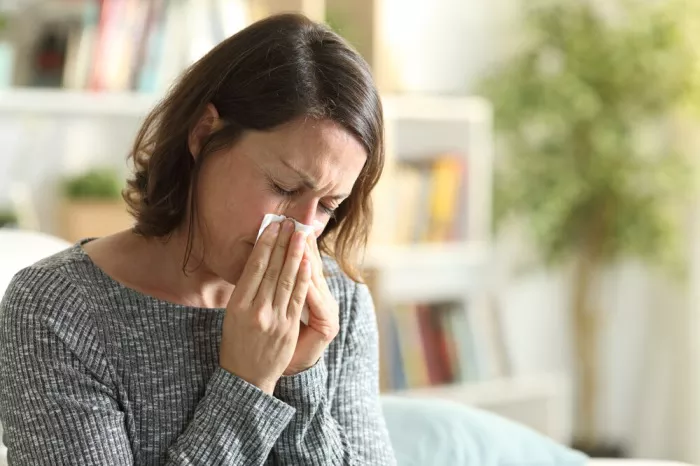Oral allergy syndrome (OAS) is a common condition that affects individuals who are allergic to certain types of pollen. OAS is also known as pollen-food allergy syndrome and is characterized by itching, tingling, and swelling in the mouth and throat after consuming certain fruits, vegetables, and nuts. While there is no cure for OAS, there are several treatment options available that can help manage the symptoms and reduce the risk of complications.
Causes of Oral Allergy Syndrome
Oral allergy syndrome is caused by a cross-reaction between the proteins in certain fruits, vegetables, and nuts and the proteins in pollen. This occurs because the proteins in these foods are similar in structure to the proteins in pollen, which can cause the immune system to mistakenly identify them as harmful substances and trigger an allergic reaction.
Individuals who are allergic to pollen may be more likely to develop OAS, as their immune system is already sensitized to the proteins in pollen. Additionally, individuals who have a history of other allergies, such as hay fever or asthma, may be more likely to develop OAS.
Symptoms of Oral Allergy Syndrome
The symptoms of oral allergy syndrome can vary from mild to severe and may include:
Itching and Tingling in the Mouth and Throat: Itching and tingling in the mouth and throat are the most common symptoms of OAS. This may be accompanied by a sensation of swelling or tightness in the mouth and throat.
Swelling and Redness: Swelling and redness of the lips, tongue, and throat may occur in more severe cases of OAS.
Hives: Hives are raised, itchy bumps on the skin that may appear after consuming certain foods.
Difficulty Breathing: In rare cases, OAS can cause difficulty breathing, which may be life-threatening. This may be accompanied by wheezing, chest tightness, and shortness of breath.
Treatment Options for Oral Allergy Syndrome
While there is no cure for oral allergy syndrome, there are several treatment options available that can help manage the symptoms and reduce the risk of complications. Some of the treatment options include:
Avoidance: The most effective way to manage OAS is to avoid the foods that trigger the allergic reaction. This may involve reading food labels carefully and avoiding foods that contain the proteins that cross-react with pollen.
Cooking or Peeling: In some cases, cooking or peeling the fruits and vegetables that trigger the allergic reaction may help reduce the risk of an allergic reaction. This is because cooking or peeling can break down the proteins that cross-react with pollen.
Antihistamines: Antihistamines are medications that can help relieve the symptoms of OAS, such as itching and swelling. Antihistamines work by blocking the release of histamine, which is a chemical that is released by the immune system in response to an allergen.
Immunotherapy: Immunotherapy is a long-term treatment option that may be recommended for individuals with severe or persistent OAS. Immunotherapy involves exposing the individual to small amounts of the allergen over a period of time, which can help desensitize the immune system and reduce the severity of the allergic reaction.
Avoidance of Foods that Trigger OAS
The most effective way to manage OAS is to avoid the foods that trigger the allergic reaction. This may involve reading food labels carefully and avoiding foods that contain the proteins that cross-react with pollen.
Individuals with OAS should also be aware of the foods that are most likely to trigger an allergic reaction. Some of the most common foods that trigger OAS include:
Apples
Bananas
Carrots
Celery
Melons
Peaches
Pears
Tomatoes
Cooking or Peeling Fruits and Vegetables
In some cases, cooking or peeling the fruits and vegetables that trigger the allergic reaction may help reduce the risk of an allergic reaction. This is because cooking or peeling can break down the proteins that cross-react with pollen.
However, it is important to note that cooking or peeling may not be effective for all individuals with OAS and may not completely eliminate the risk of an allergic reaction. Additionally, some individuals with OAS may be allergic to the cooked or peeled form of the food, which can cause a different type of allergic reaction.
Antihistamines for Oral Allergy Syndrome
Antihistamines are medications that can help relieve the symptoms of OAS, such as itching and swelling. Antihistamines work by blocking the release of histamine, which is a chemical that is released by the immune system in response to an allergen.
There are several types of antihistamines available, including first-generation antihistamines and second-generation antihistamines. First-generation antihistamines, such as diphenhydramine (Benadryl), may cause drowsiness and other side effects. Second-generation antihistamines, such as loratadine (Claritin) and cetirizine (Zyrtec), are less likely to cause drowsiness and may be preferred for long-term use.
Immunotherapy for Oral Allergy Syndrome
Immunotherapy is a long-term treatment option that may be recommended for individuals with severe or persistent OAS. Immunotherapy involves exposing the individual to small amounts of the allergen over a period of time, which can help desensitize the immune system and reduce the severity of the allergic reaction.
Immunotherapy may be administered through injections or sublingual tablets, depending on the individual’s needs and preferences. Immunotherapy requires regular monitoring and may take several months or years to complete.
Prevention of Oral Allergy Syndrome
The best way to prevent OAS is to avoid exposure to the foods that trigger the allergic reaction. This may involve reading food labels carefully and avoiding foods that contain the proteins that cross-react with pollen. It is also important to inform healthcare providers and caregivers about your allergy to pollen and OAS so that they can take appropriate precautions.
In addition to avoiding the foods that trigger OAS, it is also important to maintain a healthy diet and lifestyle to support a healthy immune system. This may involve eating a balanced diet that is rich in fruits, vegetables, and whole grains, as well as engaging in regular physical activity and getting enough sleep.
Conclusion
Oral allergy syndrome is a common condition that affects individuals who are allergic to certain types of pollen. While there is no cure for OAS, there are several treatment options available that can help manage the symptoms and reduce the risk of complications. These treatment options may include avoidance, cooking or peeling, antihistamines, and immunotherapy. It is important to consult a healthcare professional if you suspect that you may have OAS, as they can provide a proper diagnosis and recommend the most appropriate treatment plan. Additionally, it is important to take steps to prevent OAS by avoiding exposure to the foods that trigger the allergic reaction and maintaining a healthy diet and lifestyle.
[inline_related_posts title=”You Might Be Interested In” title_align=”left” style=”list” number=”6″ align=”none” ids=”4879,4839,4832″ by=”categories” orderby=”rand” order=”DESC” hide_thumb=”no” thumb_right=”no” views=”no” date=”yes” grid_columns=”2″ post_type=”” tax=””]































